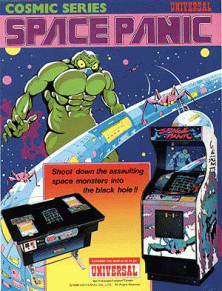Was Space Panic The First Ever Platformer?
Space Panic is an early arcade game from Universal, released in 1980 and believed to be the first ever platform game, predating Donkey Kong by a full year. This was also the first successful game by arcade developer Universal, who later created the classic Mr Do!.

Universal Space Panic
The game is set around a series of platforms connected by ladders, which your player character and also the alien monsters can use to move around the screen. Your character in Space Panic cannot jump, and is therefore reliant on using the ladders to avoid the patrolling aliens. In order to destroy the monsters, you must set traps for them by digging holes in the platforms with your spade, in the hope that the monsters will fall in.
Once they are in the hole, you have to bash them with your spade to make them fall through the platform to their doom. Fall through the hole yourself, or touch a monster, and you lose a life. You also have a limited supply of oxygen, and you must clear all of the monsters before your supply runs out.
Experienced players of Space Panic will use the hole mechanic to slow down the monsters, as even a partially dug hole will trap a monster momentarily, and if you can place yourself between two holes then you are fairly safe. If you could time the drop of the alien through hole perfectly and you could also take out another alien beneath the hole. In later levels you would need to drop the aliens through 2 levels or more to kill them, increasing the difficulty of the game significantly.
Space Panic conversions for consoles and home computers
Space Panic had some popular home conversions, most notably an official version for the Colecovision system, and a great clone by Acornsoft for the BBC Micro. I didn’t get to play the Colecovision version of Space Panic until very recently, and I can confirm it is hilarious, with your character goose-stepping around the screen, armed only with what appears to be a chicken drumstick.

Back in the day I had a BBC Micro, and a copy of Monsters, Acorn’s Space Panic clone. As with all of the Acornsoft arcade clones it was excellent, and a great home version of Universal’s original platformer. My favourite strategy was to dig holes beneath each other on all the platforms and then try and trap a monster at the top, so they would fall all the way down the screen for extra points.
Nintendo may have refined the platform gaming formula with the runaway success Donkey Kong, but it was Universal’s Space Panic that started the genre, and with it a simple but addictive arcade game.




